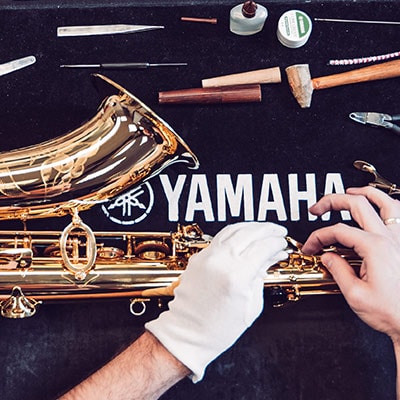Handmade wooden flutes are suitable not just for solo and chamber music, but also for use in the modern symphony orchestra. Their remarkable tonal projection is the result of combining the state-of-the-art scale with Yamaha's unique "Type EW" headjoint, and of their specially designed toneholes - which are the same size as on metal flutes. An "Type HW" headjoint is optionally available.
Lineup
800W Series
- All models are available with a B footjoint; add H to the model number when ordering.
Key Types
Covered (or Plateau) keys are easy to use. The pad cup is covered so it will seal the tonehole any time the key is closed. This is common with beginners or others who may not always press the center of the key.
Many advanced players prefer the open feel of Ring keys for subtle control of their tone. Intermediate and Standard model French system flutes come with key plugs to seal the hole until players have become adept at covering the holes with their fingers.
Covered Keys
Ring (French) Keys
Klappensysteme (811 und 812)
Many players find the Offset G configuration easier to play. Often teachers recommend that beginners start on these flutes, while more and more advanced players are also choosing this natural feeling configuration. Many advanced students and professionals, though, still prefer the traditional In-line formation where all the toneholes are in a straight row.
in-line
Offset G
Split E Mechanism
This key helps give more stability and better centered intonation to the high E.
Footjoints
The B footjoint has an extra key enabling the player to play 1/2 step lower than the lowest note of the C foot. It also affects the sound; B footjoint enables a darker, stronger sound with good projection, while C footjoint has flexible, warmer tone.
H-Fußstück
C Footjoint
Features
1
Die Mundlochplatte und das Kopfstück sind aus einem einzigen Stück afrikanischen Grenadill-Holzes geschnitzt für eine reine, natürliche Resonanz. Die Oberfläche der Mundlochplatte ist besonders komfortabel und bietet eine sichere Kontrolle.
2
Ein Silberzapfen verbindet das Kopfstück mit dem Korpus, genau wie bei einer Silberflöte. Dies macht den Klang fokussierter. Außerdem trägt es zu einer merklichen Gewichtsverringerung der Flöte bei.
3
Ein ähnlicher Silberzapfen innerhalb der Fußstück-Verbindung verringert das Gewicht und vermeidet Rissbildung. Außerdem verleiht er dem Klang mehr Substanz, was die Projektion verbessert.
Tasten
Die Tonlöcher werden aus Grenadill-Einsätzen präzise herausgearbeitet. Dies erlaubt größere Tonloch-Durchmesser: sie entsprechen denen der Metallflöten. Dies ist ein weiterer Faktor, der zur exakten Intonation und dem reinen Klang der Flöte beiträgt.
* Die technischen Daten können ohne vorherige Ankündigung geändert werden. Die abgebildeten Farben und Oberflächen können von den tatsächlichen Produkten abweichen.

















